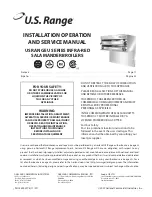
EN-2
E
n
g
lis
h
1
1
Installation
Mounting and installation must be performed by a qualified
specialist company!
The unit must be installed in a room protected from frost and
with short pipe runs.
The enamelled tanks (in accordance with DIN 4753) are
suitable for drinking water.
Mixed installation is permitted.
The connection is to be carried out in accordance with DIN
1988 and DIN 4753 Part 1. All connecting sleeves which are
not required should be sealed with vent plugs.
The bare-tube heat exchanger needs to be flushed with
water prior to connecting the hot water pipeline.
The maximum permissible operating overpressure indicated
on the type plate must not be exceeded. If applicable,
installation of a pressure reducer is required.
Electrical installations should only be connected by
authorised electricians according to the corresponding
circuit diagram. The electrical installation must be carried
out in accordance with all relevant requirements of the utility
company and VDE regulations.
According to DIN 806-2, scalding protection must be
provided for cylinder temperatures over 45°C in
consideration of DVGW W551.
Recommendation:
In order to level transient pressure or water impact in the cold
water network and avoid unnecessary loss of water, we
recommend installing a fitted expansion vessel with a perfusion
device.
2
Start-up
Ensure that the water supply is turned on and the tank is
filled before start-up. The initial filling and start-up must be
carried out by a qualified specialist company.
The entire system, including all factory-assembled
components, should be inspected to ensure that everything
is working properly and that there is no leakage.
The operational reliability of the safety valve should be
checked at regular intervals. We recommend having an
annual service inspection carried out by a qualified specialist
company.
The electrical installation (if present) should be decalcified
once a year or more frequently in particularly hard water
areas. This should be combined with an operational test.
We recommended having the tank cleaned and the system
checked once a year.
Reasonable operation can save a considerable amount of
energy.
The hot water temperature should not exceed 45°C when
the heat pump is in operation.
ATTENTION!
According to the specifications of the German Technical and Scientific
Association for Gas and Water (DVGW), the
magnesium anode
should initially be inspected by after-sales service after 2 years of use
and then at regular intervals and replaced when necessary. (Renew
anode when protective current less than 0.3 mA)






















